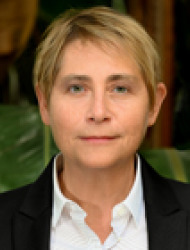
University of Southern California, Director, Visual Studies Research
Bio: Vanessa R. Schwartz is Professor of Art History and History at the University of Southern California, where she directs the Visual Studies Research Institute and its graduate certificate program. A graduate of Princeton University (Magna Cum Laude and Phi Beta Kappa, 1986) she received her PhD in History at the University of California, Berkeley in 1993.
Schwartz specializes in 19th and 20th c. European and American visual culture, especially photography, film and design. Her new book Jet Age Aesthetic: The Glamour of Motion in Motion is now available (Yale University Press) and was supported by a Millard Meiss award from the College Art Association and a Furthermore Foundation grant. With Jason Hill, she co-edited Getting the Picture: The Visual Culture of the News (2015). She is also an advisor to the curatorial teams working on a show at the Musée d’Orsay and LACMA about the origins of cinema, to open in Paris in September 2021 and in Spring 2022 in LA.
Course Information:
Visual History: The Past in Pictures
Images make history. They document events, preserve memories, allow us to witness at a distance, and move us to act. Images can serve as both records and sources for the writing of history. This graduate seminar investigates the history of “writing” history in images (what Hayden White termed “historiophoty”) from the rise of European print culture circa 1450 to the global spread of digital media in the present, with an emphasis on the Western tradition and experience, including its imperial contexts. By investigating the many ways in which histories have been told with and in images, we aim to contextualize the current ubiquity of visually mediated evidence, documentation, and narrative. In the age of digital media, the power of images to transmit information in the present and craft accounts about the past appears obvious. That power, however, rests on a series of widely held and sometimes contradictory assumptions, among them: that images can be trusted as evidence if their provenance and accuracy are judged adequate; that images have greater emotional impact than words, but are on their own insufficient to write history and thus serve as illustrations to textual narratives; and that images are more universal and more capable of traversing geographic distances and cultural differences than words, except when impeded by unbreachable culturally-specific interpretive walls. The epistemic work of images, their evidentiary status in relation to words and things, and their perceived value as both historical sources and historical accounts have shifted again and again in the period our seminar examines, as have notions of what “history” itself means. This class will benefit students in history as well as the history of art and all humanities and social science graduate students interested in using images assources as well as those considering the issues of time and change in their work.
Public Lecture: “From News to History: The Visual Economy of Time-Life Books" will take place on May 9th.

